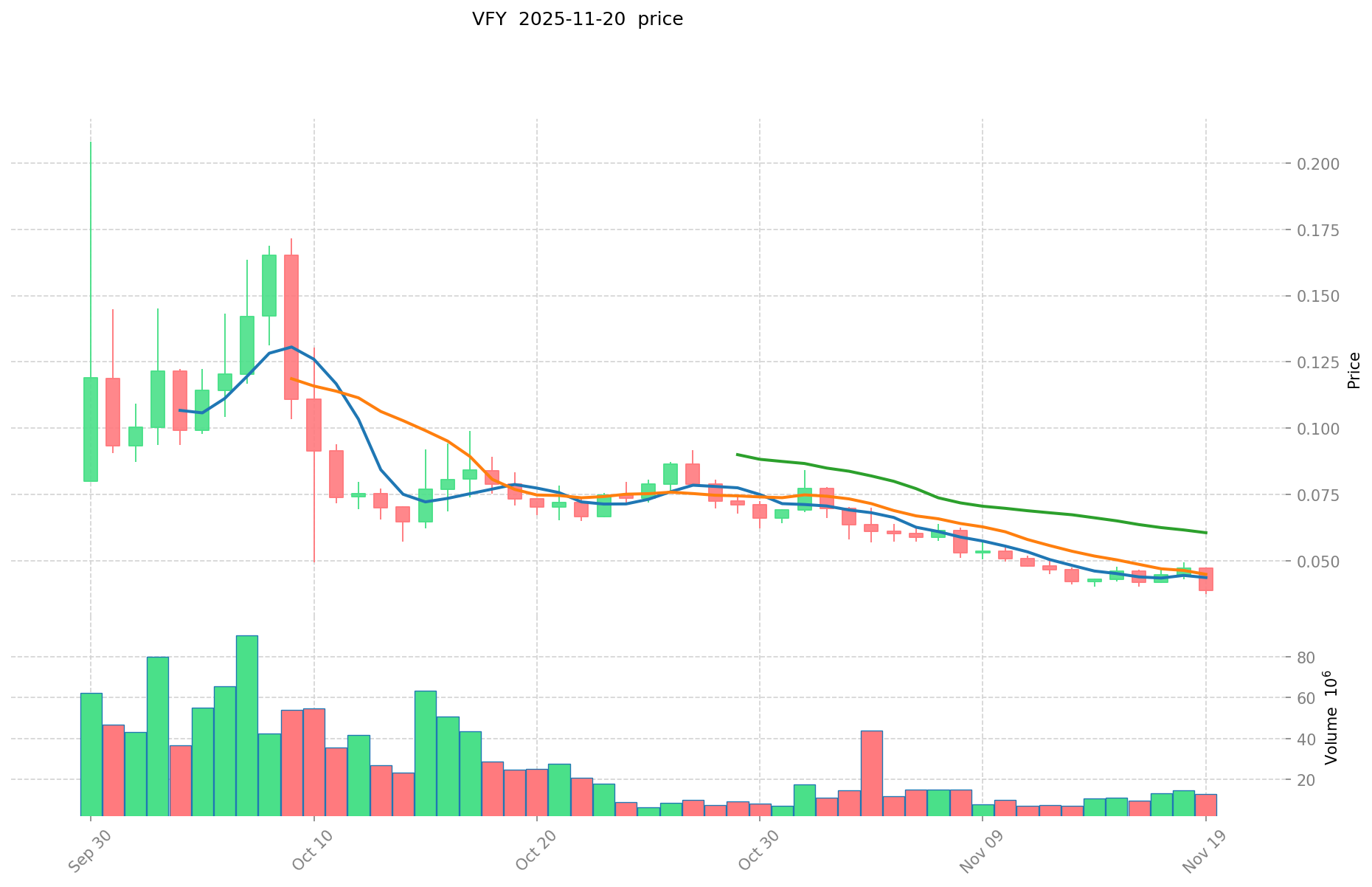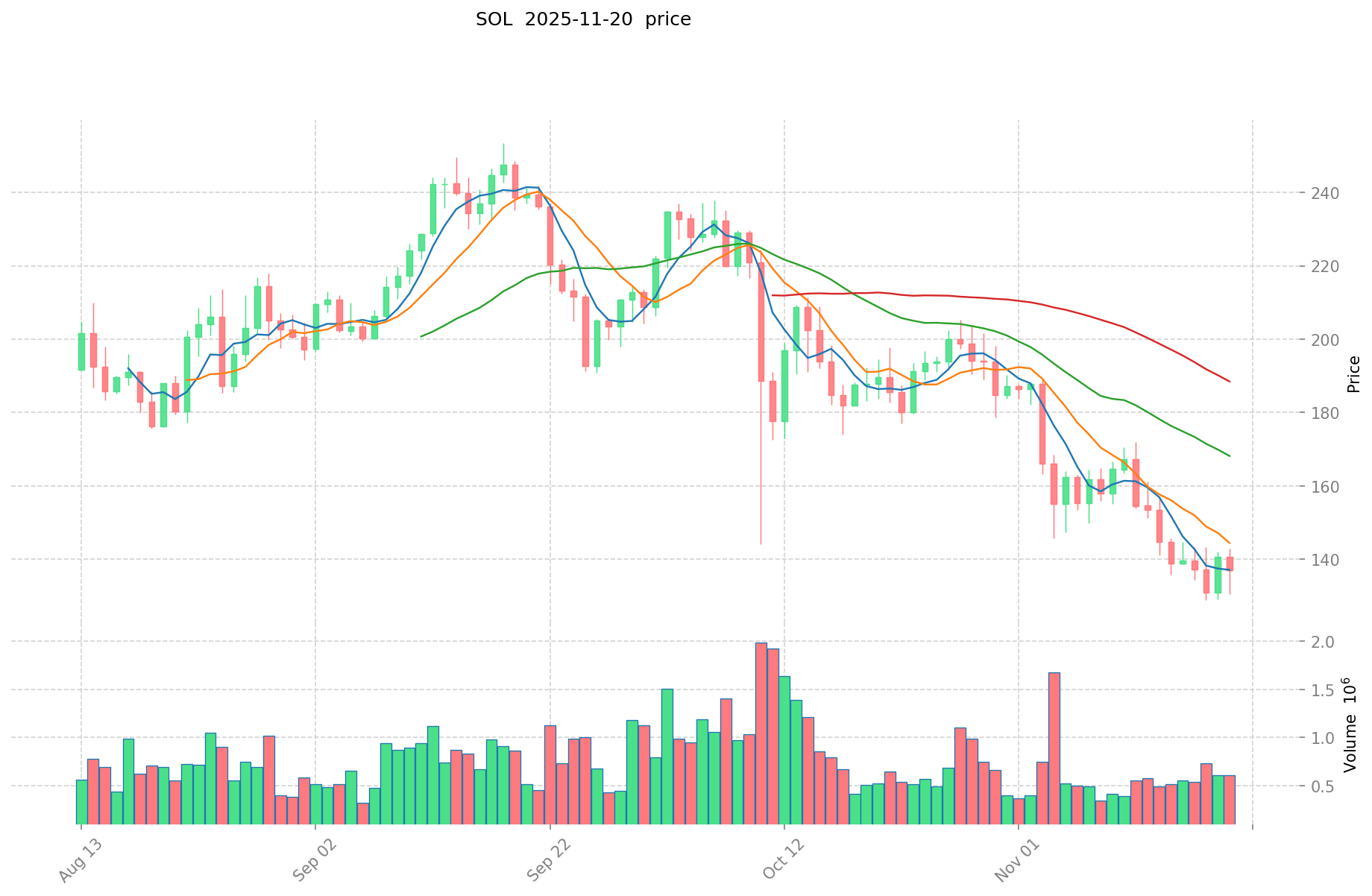VFY vs SOL: A Comparative Analysis of Blockchain Scalability Solutions
Introduction: Investment Comparison of VFY vs SOL
In the cryptocurrency market, the comparison between VFY and SOL has always been a topic that investors cannot avoid. The two not only have significant differences in market cap ranking, application scenarios, and price performance, but also represent different cryptocurrency positionings.
zkVerify (VFY): Since its launch, it has gained market recognition for its universal proof verification layer for real-world applications across the Internet.
Solana (SOL): Since its inception in 2017, it has been hailed as a high-performance blockchain protocol, and is one of the cryptocurrencies with the highest global trading volume and market capitalization.
This article will provide a comprehensive analysis of the investment value comparison between VFY and SOL, focusing on historical price trends, supply mechanisms, institutional adoption, technological ecosystems, and future predictions, attempting to answer the question investors care about most:
"Which is the better buy right now?"
I. Price History Comparison and Current Market Status
VFY and SOL Historical Price Trends
- 2025: VFY reached its all-time high of $0.20814 on September 30, then declined to its all-time low of $0.03726 on November 19.
- 2025: SOL hit its all-time high of $293.31 on January 19, showing significant price volatility throughout the year.
- Comparative analysis: In this market cycle, VFY dropped from its peak of $0.20814 to a low of $0.03726, while SOL experienced a decline from $293.31 to current levels, demonstrating greater price stability compared to VFY.
Current Market Situation (2025-11-21)
- VFY current price: $0.0383
- SOL current price: $133.57
- 24-hour trading volume: VFY $492,813.60503 vs SOL $97,860,742.7803
- Market Sentiment Index (Fear & Greed Index): 11 (Extreme Fear)
Click to view real-time prices:
- Check VFY current price Market Price
- Check SOL current price Market Price
<>
二、项目简介与技术特点
{VFY}
{SOL}
>


II. Core Factors Affecting Investment Value of VFY vs SOL
Supply Mechanism Comparison (Tokenomics)
- VFY: Deflationary model with a portion of transaction fees burned, creating scarcity over time
- SOL: Inflationary model with decreasing annual issuance rate, currently around 8% and designed to reduce to approximately 1.5% long-term
- 📌 Historical Pattern: Deflationary tokens like VFY tend to perform better during bull markets, while SOL's controlled inflation supports network security and validator participation.
Institutional Adoption and Market Applications
- Institutional Holdings: SOL currently enjoys significantly greater institutional investment with major funds like Alameda Research, Multicoin Capital, and Andreessen Horowitz maintaining large positions
- Enterprise Adoption: SOL has established partnerships with numerous organizations for payment processing and settlement solutions, while VFY is still developing its enterprise use cases
- Regulatory Stance: Both tokens face varying regulatory scrutiny across jurisdictions, with SOL generally receiving more regulatory clarity due to its established presence
Technical Development and Ecosystem Building
- VFY Technical Upgrades: Implementing Lightning Network compatibility and cross-chain interoperability features
- SOL Technical Development: Focused on improving scalability and throughput with recent upgrades to reduce network congestion
- Ecosystem Comparison: SOL has a more developed ecosystem with numerous DeFi protocols, NFT marketplaces, and dApps, while VFY's ecosystem is younger with growing DeFi and payment solutions
Macroeconomic and Market Cycles
- Performance During Inflation: SOL has historically shown higher correlation with traditional markets during inflationary periods, while VFY may offer better inflation hedging properties
- Macroeconomic Monetary Policy: Interest rate hikes tend to impact both tokens negatively, with SOL showing slightly higher sensitivity to changes in monetary policy
- Geopolitical Factors: Cross-border transaction demand benefits both tokens, though VFY may have advantages in regions with currency instability
III. 2025-2030 Price Prediction: VFY vs SOL
Short-term Prediction (2025)
- VFY: Conservative $0.0197704 - $0.03802 | Optimistic $0.03802 - $0.049426
- SOL: Conservative $87.8922 - $133.17 | Optimistic $133.17 - $157.1406
Mid-term Prediction (2027)
- VFY may enter a growth phase, with prices expected in the range of $0.0487030497 - $0.07512704475
- SOL may enter a bullish market, with prices expected in the range of $121.3498308 - $209.1687873
- Key drivers: Institutional capital inflow, ETF, ecosystem development
Long-term Prediction (2030)
- VFY: Base scenario $0.067187453187027 - $0.085047409097503 | Optimistic scenario $0.085047409097503 - $0.089299779552378
- SOL: Base scenario $180.451739837182275 - $243.85370248267875 | Optimistic scenario $243.85370248267875 - $273.1161467806002
Disclaimer: This information is for educational purposes only and should not be considered as financial advice. Cryptocurrency markets are highly volatile and unpredictable. Always conduct your own research before making any investment decisions.
VFY:
| 年份 | 预测最高价 | 预测平均价格 | 预测最低价 | 涨跌幅 |
|---|---|---|---|---|
| 2025 | 0.049426 | 0.03802 | 0.0197704 | 0 |
| 2026 | 0.05990051 | 0.043723 | 0.03541563 | 14 |
| 2027 | 0.07512704475 | 0.051811755 | 0.0487030497 | 35 |
| 2028 | 0.07425919785375 | 0.063469399875 | 0.03490816993125 | 65 |
| 2029 | 0.101230519330631 | 0.068864298864375 | 0.042007222307268 | 79 |
| 2030 | 0.089299779552378 | 0.085047409097503 | 0.067187453187027 | 122 |
SOL:
| 年份 | 预测最高价 | 预测平均价格 | 预测最低价 | 涨跌幅 |
|---|---|---|---|---|
| 2025 | 157.1406 | 133.17 | 87.8922 | 0 |
| 2026 | 174.18636 | 145.1553 | 105.963369 | 8 |
| 2027 | 209.1687873 | 159.67083 | 121.3498308 | 19 |
| 2028 | 245.2783455045 | 184.41980865 | 171.5104220445 | 37 |
| 2029 | 272.8583278881075 | 214.84907707725 | 131.0579370171225 | 60 |
| 2030 | 273.1161467806002 | 243.85370248267875 | 180.451739837182275 | 82 |
IV. Investment Strategy Comparison: VFY vs SOL
Long-term vs Short-term Investment Strategy
- VFY: Suitable for investors focused on emerging technologies and ecosystem potential
- SOL: Suitable for investors seeking established networks with proven scalability
Risk Management and Asset Allocation
- Conservative investors: VFY: 10% vs SOL: 90%
- Aggressive investors: VFY: 30% vs SOL: 70%
- Hedging tools: Stablecoin allocation, options, cross-currency portfolio
V. Potential Risk Comparison
Market Risk
- VFY: Higher volatility due to lower market cap and trading volume
- SOL: Susceptible to broader market trends and institutional capital flows
Technical Risk
- VFY: Scalability, network stability
- SOL: Network congestion, potential for outages
Regulatory Risk
- Global regulatory policies may impact both tokens differently, with SOL potentially facing more scrutiny due to its larger market presence
VI. Conclusion: Which Is the Better Buy?
📌 Investment Value Summary:
- VFY advantages: Emerging technology with potential for high growth, deflationary model
- SOL advantages: Established ecosystem, institutional adoption, proven scalability
✅ Investment Advice:
- New investors: Consider a small allocation to VFY while maintaining a larger position in SOL
- Experienced investors: Balance portfolio with both tokens, adjusting based on risk tolerance
- Institutional investors: Focus on SOL for liquidity and established market presence, monitor VFY for potential future opportunities
⚠️ Risk Warning: Cryptocurrency markets are highly volatile. This article does not constitute investment advice. None
VII. FAQ
Q1: What are the main differences between VFY and SOL? A: VFY is a newer project focused on universal proof verification, while SOL is an established high-performance blockchain protocol. VFY has a deflationary tokenomics model, whereas SOL has a controlled inflationary model. SOL has a more developed ecosystem and greater institutional adoption, while VFY is still growing its use cases and partnerships.
Q2: Which token has shown better price stability? A: Based on the provided information, SOL has demonstrated greater price stability compared to VFY in the current market cycle. VFY experienced a significant drop from its all-time high of $0.20814 to a low of $0.03726, while SOL's price movements have been less volatile.
Q3: How do the supply mechanisms of VFY and SOL differ? A: VFY employs a deflationary model where a portion of transaction fees are burned, creating scarcity over time. SOL, on the other hand, has an inflationary model with a decreasing annual issuance rate, currently around 8% and designed to reduce to approximately 1.5% long-term.
Q4: What are the key factors affecting the investment value of VFY and SOL? A: The main factors include supply mechanisms, institutional adoption, market applications, technical development, ecosystem building, and macroeconomic conditions. SOL currently has advantages in institutional adoption and ecosystem development, while VFY offers potential for growth in emerging technologies.
Q5: How do VFY and SOL compare in terms of long-term price predictions? A: For 2030, VFY's base scenario price range is predicted to be $0.067187453187027 - $0.085047409097503, with an optimistic scenario of $0.085047409097503 - $0.089299779552378. SOL's base scenario for 2030 is $180.451739837182275 - $243.85370248267875, with an optimistic scenario of $243.85370248267875 - $273.1161467806002.
Q6: What investment strategies are recommended for VFY and SOL? A: For conservative investors, a suggested allocation is 10% VFY and 90% SOL. For aggressive investors, the recommendation is 30% VFY and 70% SOL. New investors might consider a small allocation to VFY while maintaining a larger position in SOL, while experienced investors could balance their portfolio with both tokens based on their risk tolerance.
Q7: What are the potential risks associated with investing in VFY and SOL? A: VFY faces higher volatility due to its lower market cap and trading volume, as well as potential scalability and network stability issues. SOL is susceptible to broader market trends, institutional capital flows, and has experienced network congestion and outages. Both tokens may be impacted by regulatory risks, with SOL potentially facing more scrutiny due to its larger market presence.
Share
Content